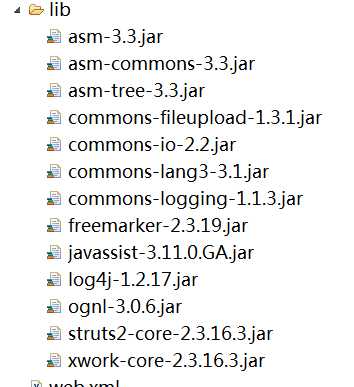标签:
Struts2以WebWork优秀的设计思想为核心,吸收了Struts1的部分优点,建立了一个基于WebWork和Struts1的MVC框架。
2.1、通过官网下载最新版:http://struts.apache.org/download.cgi
建议下载struts-xx.all.zip包,压缩包中不仅包含struts2的jar还包含了示例、源码以及帮助文档。
2.2、在项目中导入Struts2需要的jar包
2.3、修改web.xml文件
在web.xml文件的<web-app>节点下添加StrutsPrepareAndFilter核心过滤器,主要负责拦截用户的请求,交给Struts2的框架进行处理。
2.4、添加struts.xml配置文件。
struts.xml是Struts2的核心配置文件,该文件通常放在src目录下,编译部署以后,他就到了应用程序的WEB-INF\classes目录下。
3.1、新建web项目,并导入struts的jar包

3.2、添加Action类
实现Action可以有三种方法:
1.使用普通的Java类,编写public String execute()方法
2.实现Action接口,实现execute()方法
3.继承ActionSupport类,重写execute()方法。
package com.able.action;
import com.opensymphony.xwork2.Action;
import com.opensymphony.xwork2.ActionSupport;
/**
*
* @author 夏中伟
* 实现Action可以有三种方法:
* 1.使用普通的Java类,编写public String execute()方法
* 2.实现Action接口,实现execute()方法
* 3.继承ActionSupport类,重写execute()方法。
* userAction这里继承ActionSupport
*/
public class UserAction extends ActionSupport {
private String name;
private String message;
public String getName() {
return name;
}
public void setName(String name) {
this.name = name;
}
public String getMessage() {
return message;
}
public void setMessage(String message) {
this.message = message;
}
/**
* 这个方法名可以随便写
* @return
*/
public String execute(){
System.out.println(name+"-----------------");
message="Hello World"+name;
return "abc";
}
}
3.3、修改web.xml
<?xml version="1.0" encoding="UTF-8"?>
<web-app xmlns:xsi="http://www.w3.org/2001/XMLSchema-instance" xmlns="http://java.sun.com/xml/ns/javaee" xsi:schemaLocation="http://java.sun.com/xml/ns/javaee http://java.sun.com/xml/ns/javaee/web-app_2_5.xsd" id="WebApp_ID" version="2.5">
<display-name>Struts2_Demo</display-name>
<welcome-file-list>
<welcome-file>index.jsp</welcome-file>
</welcome-file-list>
<filter>
<filter-name>struts2</filter-name>
<filter-class>org.apache.struts2.dispatcher.ng.filter.StrutsPrepareAndExecuteFilter</filter-class>
</filter>
<filter-mapping>
<filter-name>struts2</filter-name>
<url-pattern>/*</url-pattern>
</filter-mapping>
</web-app>
3.4、在src目录下添加struts.xml,并添加相应的配置
<?xml version="1.0" encoding="UTF-8" ?>
<!DOCTYPE struts PUBLIC
"-//Apache Software Foundation//DTD Struts Configuration 2.3//EN"
"http://struts.apache.org/dtds/struts-2.3.dtd">
<struts>
<constant name="struts.enable.DynamicMethodInvocation" value="false" />
<!-- 修改了Struts.xml需要重启web服务配置才能生效,为了避免多次重启web服务设置以下常量 -->
<constant name="struts.devMode" value="true" />
<package name="default" namespace="/" extends="struts-default">
<default-action-ref name="index" />
<global-results>
<result name="error">/err.jsp</result>
</global-results>
<global-exception-mappings>
<exception-mapping exception="java.lang.Exception" result="error"/>
</global-exception-mappings>
<!-- 执行的是代理类 -->
<action name="userAction" class="com.able.action.UserAction" method="execute">
<result name="abc" >index.jsp</result> <!--type="forword"-->
</action>
<action name="login" class="com.able.action.LoginFieldAction">
<result name="success">index.jsp</result>
</action>
</package>
<!-- <include file="exemple.xml"></include> -->
<!-- Add packages here -->
</struts>
3.5、修改index.jps文件
<%@ page language="java" import="java.util.*" pageEncoding="UTF-8"%>
<%
String path = request.getContextPath();
String basePath = request.getScheme()+"://"+request.getServerName()+":"+request.getServerPort()+path+"/";
%>
<%@taglib uri="/struts-tags" prefix="s" %>
<!DOCTYPE HTML PUBLIC "-//W3C//DTD HTML 4.01 Transitional//EN">
<html>
<head>
<base href="<%=basePath%>">
<title>My JSP ‘index.jsp‘ starting page</title>
<meta http-equiv="pragma" content="no-cache">
<meta http-equiv="cache-control" content="no-cache">
<meta http-equiv="expires" content="0">
<meta http-equiv="keywords" content="keyword1,keyword2,keyword3">
<meta http-equiv="description" content="This is my page">
<!--
<link rel="stylesheet" type="text/css" href="styles.css">
-->
</head>
<body>
<form action="userAction">
用户名:<input name="name"/><br/>
<input type="submit" value="提交"/>
</form>
<div>
<s:property value="message"/>
</div>
<div id="通过属性传值,以及modelDriven的接收">
刚刚输入的用户名:
<s:property value="username"/><br/>
<s:property value="password"/>
</div>
**********************分割线*************************
<div>
这是通过javaBean方式获取的用户名和密码
<s:property value="user.username"/><br/>
<s:property value="user.password"/>
</div>
</body>
</html>
3.6、将项目添加到tomcat中启动项目,在浏览器中输入:localhost:8080/Struts2_Demo(自己的项目名)/userAction
就可以看到页面跳转到index.jsp页面,然后在文本框中输入xiazhongwei提交后,在下边输出message,

4.1、在浏览器中请求userAction时会经过Struts的核心过滤器“StrutsPrepareAndExecuteFilter”,
4.2、核心过滤器会根据请求在struts.xml中匹配name相同的action,然后会跳转到相应action处理类userAction类,
4.3、会在userAction寻找与struts.xml中配置的<action method=“exectue”>标签中属性method相同值的方法,默认执行行方法名是execute()方法,如果在标签中定义method="add",就回在userAction方法中寻求add的方法。
4.4、执行完execute()方法后根据返回值String,寻找匹配struts.xml中<action></action>标签中的<resutl>值相同的result
4.5、根据类型跳转相应的请求中,上示例定义跳转到index.jsp中,所以会在页面中看到userAction类中execute方法中返回的message值“Hello world ”+name,name是页面提交表单中的值
标签:
原文地址:http://www.cnblogs.com/izhongwei/p/5636606.html